The masterpieces of Venetian textile in the Holy Land: “for the glory of God”
It is known that the regalia represent one of the most precious goods of the ecclesiastic art. Since the beginning, both the Occidental and Oriental Church liturgies aim to put light on the Church’s greatness in the divine mystery during the celebrations and the rites.
The liturgical vestments in Jerusalem, where the Franciscans of the Custody of the Holy
Land solemnly celebrate the Latin Liturgy of the Catholic Church in the Holy Places, are one of the most important elements of the Liturgical office, mostly during the solemn ceremonies. Well known is in fact the Franciscan sensibility towards the liturgical beauty, the special treatment for the sacristies and the respect and the honor for the Blessed Sacrament.
These textiles, often the results of donations, represent one of the most precious goods of the Custody’s Treasure. Among the big European powers linked with the Holy Land, Venice, together with Spain, Reign of Naples, and France, had an important role in donations by virtue of its close bond to this land. Venice had been for many centuries the only pilgrim’s gate and the only defense of the Franciscans and the Holy Places.
Together with silvers or the Pharmacy’s ceramics, the Venice vestments are a real artistic treasure. We report three beautiful examples from the XVI century to the XIX century.
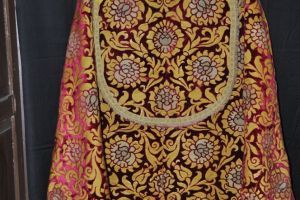 The first example is the Venetian vestment, coming from the Nativity Church of Bethlehem. This object is still being studied and it’s datable between the second half of the XVI century and the beginning of the XVI century. The vestment is in red velvet background, gold interfacing,
The first example is the Venetian vestment, coming from the Nativity Church of Bethlehem. This object is still being studied and it’s datable between the second half of the XVI century and the beginning of the XVI century. The vestment is in red velvet background, gold interfacing,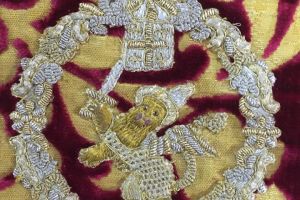 worked with floral motifs, and yellow and gold volutes with lotus and thistle flowers.
worked with floral motifs, and yellow and gold volutes with lotus and thistle flowers.
The origin is demonstrated by the presence of a particular Lion of St. Mark, embroidered in silver, dressed with the armor and a drawn sword. According to the professor Doretta Davanzo-Poli and her on-going study it could refer to the Turks of the second half of the‘500. A recent lecture about a flower decoration on the humeral veil held by the professor is really interesting; according to 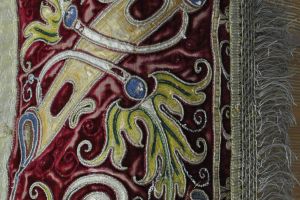 her, this could represent Isaiah’s prophecy:
her, this could represent Isaiah’s prophecy:
“There shall come forth a Rod from the stem of Jesse, and a Branch shall grow out of his roots. The Spirit of the Lord shall rest upon Him” (Is. 11, 1-2). This explanation is explicable for the symbolical value that both the Jesse’s tree and the Communion have: they both represent life. The vestments, in fact, in their rich and complex decorations often hide allegorical meanings and symbols which clothed the celebrant during the Mass or the processions; in a reminiscence of shapes, colors and symbolism that express the celebrated mystery.
The second example is the “ Parato di Venezia” (a Venetian vestment) which is one of the most important thing in the treasure of the Custody of the Holy Land.
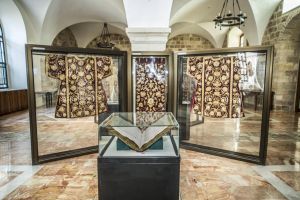 The vestment, made by a set of 27 pieces (Currently 17: casula, dalmatica (2), pivot, stole, handpiece (3), Bag for body, veil for goblet, ummer veil, antependium or paliotto, mitra, pillows (2)), arrived in Jerusalem between 1669 and 1675, as it is recorded in the “Good’s Book” (1615-1720):“Un paramento sontuossissimo di veluto
The vestment, made by a set of 27 pieces (Currently 17: casula, dalmatica (2), pivot, stole, handpiece (3), Bag for body, veil for goblet, ummer veil, antependium or paliotto, mitra, pillows (2)), arrived in Jerusalem between 1669 and 1675, as it is recorded in the “Good’s Book” (1615-1720):“Un paramento sontuossissimo di veluto
cremesino tutto ricamato de oro et argento, dire Pianeta e due Tonicelle, con suoi tre Camisi solemni et amiti con li cordoni di setta y oro" (December 10, 1669).
The origin of this vestment is clearly indicated by the letters that we found in it: “C.D.V.” which means Venice Commissariat, and by the small lions. We can clearly understand the recipients of this gift, whose identity is indicated 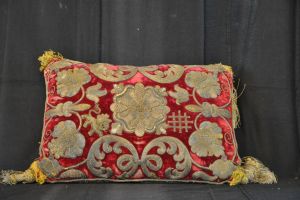 by the emblem of the Custody of the Holy Land. These liturgical vestments are really artistic masterpieces.
by the emblem of the Custody of the Holy Land. These liturgical vestments are really artistic masterpieces.
Even if the embroidery is not perfectly reported in the new background originally it was made by cut velvet among all the most valuable fabrics. 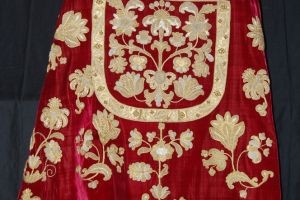 It was worked with silk threads and a double texture for creating – by hand – the fur effect that characterizes it. (Unlike the curly velvet in the united or cut one, the ring formed by the fur coat is locked in the same pass and then cut to the top with a blade; the iron for this work has an ogival section with a groove at the top for the sliding of the blade for this cracking operation). For this reason the velvet is so delicate and it easily wears out. As we have already stated, this fabric is precious; for a 2 cm tile, a whole working day is needed.
It was worked with silk threads and a double texture for creating – by hand – the fur effect that characterizes it. (Unlike the curly velvet in the united or cut one, the ring formed by the fur coat is locked in the same pass and then cut to the top with a blade; the iron for this work has an ogival section with a groove at the top for the sliding of the blade for this cracking operation). For this reason the velvet is so delicate and it easily wears out. As we have already stated, this fabric is precious; for a 2 cm tile, a whole working day is needed.
The embroidery was stretched out because everything was made of gold and silver, yarn, curly and lamellar, which are three types of precious metal processings to make them suitable for embroidery. The floral motifs are typically 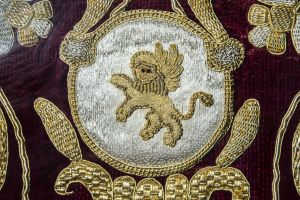 baroque, with big flowers performed with thick padding, giving bigger emphasis to the brightness of the metallic wires. The embroidery in the drawing and in the taste resembles the Coevine Venetian needle laces.
baroque, with big flowers performed with thick padding, giving bigger emphasis to the brightness of the metallic wires. The embroidery in the drawing and in the taste resembles the Coevine Venetian needle laces.
The gold-plated edges are further embellished with small garnets.
Surprisingly there are no religious motifs on the vestments besides a chalice veil which has a bernardinian monogram of Christ on it. From a historic point of view the vestments came right in the years in which Venice was losing one of its most strategic port in Candia, after that Venice progressively lost its special position between the occidental and the oriental world. Considering the circumstances in which it arrived in the Holy Land, this vestment would represent the greatness of the “Serenissima” in this Land.
Finally, we show a simple and modern vestment donated by the Venice Commissariat in 1863, as the inscription 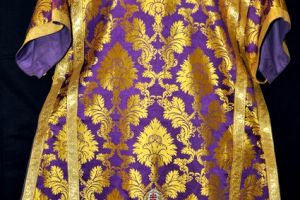 reports, Commiss. Terra Santa Venetiarum 1863. This vestment is made up of two chasubles, the stolon, three pluvial, and two tunics.
reports, Commiss. Terra Santa Venetiarum 1863. This vestment is made up of two chasubles, the stolon, three pluvial, and two tunics.
It’s really interesting that in the coat-of- arms the Cross of the Holy Land and the asburgical eagle is sewn on the pivotal, as sign of the Hasburg domination just before Italy was united. The embroidery is performed with Damask silk, purple lampas, golden gallon, green silk wool, yellow flower design.
Finally, rapidly analyzing these three examples, on one hand we can point out the richness and the artistic value of these masterpieces, typical of the baroque and of his influence in the successive year; on the other hand we underline the fundamental importance that Venice tried to show even during the liturgies. The lamps and the big candelabras, both coming from the high quality Venetian goldsmith, are really important since they still decorate the aedicule of the Holy Sepulcher; Venice wanted to appear to everyone as the only “Advocata Terrae Sanctae”.
From a wider prospective we could say that, not only the Venetian examples, but other precious vestments of the Custody of the Holy Land, demonstrate the decorative richness of the Baroque style as an artistic answer to the Trent
Council, whose aim was to “give glory to God” through the highest form of art.
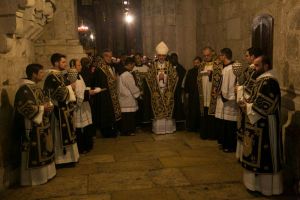 To those whom today criticize the expenses for liturgical decorations, or think that they are just pieces for museums, we can correctly respond with the words of Cardinal Martini, “Jesus appreciates beautiful things; love for worship can be judged useless only by today's mindset on efficiency”. Fortunately many of these great vestments are still worn during the most important celebrations in the Holy Land in order to underline the identity of the Catholic Church among all the professions and to show the glory of God on earth.
To those whom today criticize the expenses for liturgical decorations, or think that they are just pieces for museums, we can correctly respond with the words of Cardinal Martini, “Jesus appreciates beautiful things; love for worship can be judged useless only by today's mindset on efficiency”. Fortunately many of these great vestments are still worn during the most important celebrations in the Holy Land in order to underline the identity of the Catholic Church among all the professions and to show the glory of God on earth.
– D. VÉRON-DENISE, Chasuble d’un ornement vénitien en velours cramoisi à broderies d’or et grenats Venise, 1669, in Treasure of the Holy Sepulchre, Catalogue of the exhibition “Treasure od the Holy Sepulchre. Gift of the European Royal Courts in Jerusalem”, Château de Versailles (16 April- 14 July 2013), Milano 2013, pp. 240-241.
D. D. POLI-N.M. RICCADONA, Otto secoli di paramenti liturgici dei Frati di Venezia.Sciamiti, velluti, damaschi, broccati, ricami, Associazioni Centro Studi Antoniani, Padova 2014.
– Museo della Custodia di Terra Santa (N. 92; N. 19. N. 36), San Salvatore,
Gerusalemme.
Corrado Scardigno
(traduzione Giorgio Reggiori)



